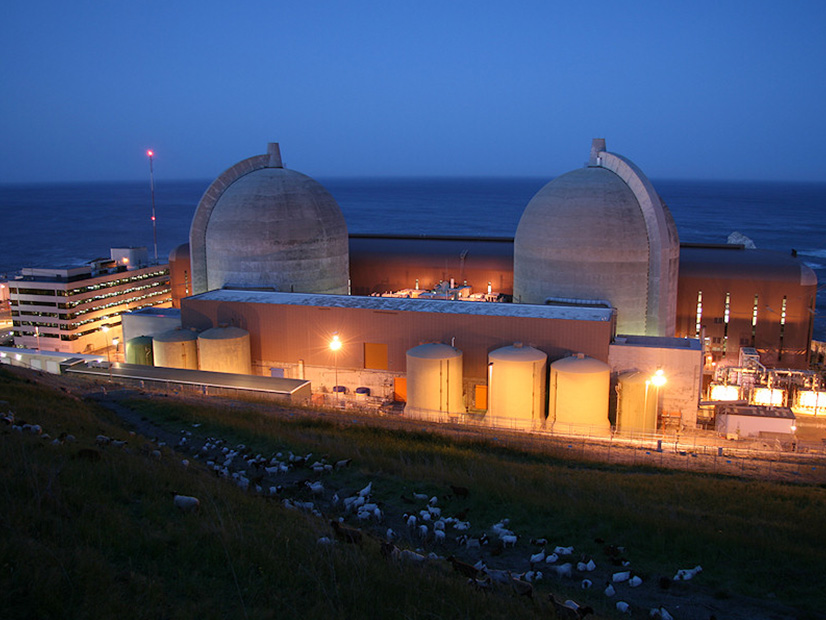
The planned closure of California's last nuclear plant at Diablo Canyon is prompting reliability concerns.
| PGEA study published this week by researchers at Stanford University and the Massachusetts Institute of Technology found that California would reap significant financial and environmental benefits by keeping its last nuclear power plant operating for at least another decade.
The authors of the paper, published on Stanford’s website, cited grid reliability during the state’s statutorily mandated switch to 100% clean power by 2045 as a prime argument for operating Pacific Gas and Electric’s (NYSE:PCG) Diablo Canyon Power Plant beyond its scheduled retirement date in 2025. The state has struggled with capacity shortfalls in the past two summers, including rolling blackouts in August 2020, and anticipates up to a 3,000-MW shortfall next summer.
“It’s important to remember that this power plant produces 15% of California’s carbon-free electricity today and is responsible for 8% of the state’s total electrical production,” co-author and MIT professor John Lienhard said in a question-and-answer session with MIT News. “In other words, Diablo Canyon is a very large factor in California’s decarbonization. When or if this plant goes offline, the near-term outcome is likely to be increased reliance on natural gas to produce electricity, meaning a rise in California’s carbon emissions.”
Postponing the plant’s retirement to 2035 would reduce the state’s reliance on natural gas, cut carbon-emissions from electricity generation by 10% compared with 2017 levels, and save ratepayers $2.6 billion in electric costs, the researchers found. Operating the plant until 2045 could save up to $21 billion and “spare 90,000 acres of land use from energy production,” by eliminating the need for 18 GW of solar arrays, they wrote.
Using energy from the nuclear plant on the Central California coast to desalinate ocean water or produce hydrogen would be added benefits, the study found.
PG&E said it would continue working toward the plant’s retirement unless ordered to do otherwise.
“We are aware of the independent study performed by Stanford and MIT. PG&E is committed to California’s clean energy future, and as a regulated utility, we are required to follow the energy policies of the state,” it said in a statement to RTO Insider. “The state has made clear its position on nuclear energy, and the plan to retire Diablo Canyon Power Plant has been approved by the California Public Utilities Commission and the state legislature. Our focus therefore remains on safely and reliably operating the plant until the end of its NRC licenses, which expire in 2024 and 2025.”
The California Public Utilities Commission, which approved the plant’s retirement, said continuing to operate it would require costly upgrades and federal approval.
“The CPUC has not been briefed on the report, and no proposal has been made directly to the CPUC to revisit the 2018 decision to allow the plant to close down after its federal licenses expire in 2024 and 2025,” CPUC Spokesperson Terrie Prosper said in an email.
“To continue operating Diablo Canyon beyond 2025 would have required a license renewal from the federal Nuclear Regulatory Commission,” Prosper said. “As part of the renewal PG&E would need to make seismic upgrades. Those upgrades combined with required changes to the cooling systems to comply with state and federal water quality laws would likely cost more than $1 billion.”
The authors of the study said their research had concluded the plant, which sits near fault lines, could withstand severe earthquakes, tsunamis and other natural disasters without upgrades.
“We reviewed the latest NRC documentation on Diablo Canyon’s seismic risk,” the paper said. “This is summarized in a very recent NRC letter, which concludes that PG&E has demonstrated the plant’s capacity to withstand the types of seismic hazards re-evaluated after Fukushima. No further actions have been required by the NRC.”
The authors also cited 2014 estimates by Bechtel Power Corp. that the cooling system fixes could be done for as little as $456 million.
The study appeared to bolster the case of a group called Californians for Green Nuclear Power (CGNP), which has argued in recent years that extending Diablo Canyon’s operation is the most cost-effective option for supplying the state’s power needs and that nuclear power is more dependable than wind and solar, making it an essential provider of baseload capacity.
FERC dismissed a CGNP complaint in March after NERC, PG&E and others argued against the group’s challenge. CGNP’s complaint claimed, in part, that the closure of Diablo Canyon violated NERC and WECC reliability standards and contended the Electric Reliability Organization had failed to exercise appropriate oversight in the matter. (See FERC Dismisses Calif. Nuclear Complaint and NERC Blasts Calif. Nuclear Group’s Complaint.)
Diablo Canyon, which went online in 1985, consists of two nuclear reactors with a nameplate capacity of 2.3 GW. In 2019, it produced nearly 16.2 TWh of electricity accounting for about 10% of in-state generation, according to the U.S. Energy Information Administration.
Its closure has been in the works since 2016, when PG&E asked the CPUC to approve a plan, created in partnership with environmental, labor and anti-nuclear advocacy groups, to begin shutting down the plant in phases between 2024 and 2025. The utility intends to replace the aging nuclear plant with wind, solar and other carbon-free resources as a means of meeting renewable energy goals set by California’s legislature in 2018 under Senate Bill 100.
Lienhard told the university news service that he hoped the new study would cause PG&E and others to revisit and reverse the decision to retire Diablo Canyon.
“We believe that this report gives the relevant stakeholders and policymakers a lot of information about options and value associated with keeping the plant running, and about how California could benefit from clean water and clean power generated at Diablo Canyon,” he said.


